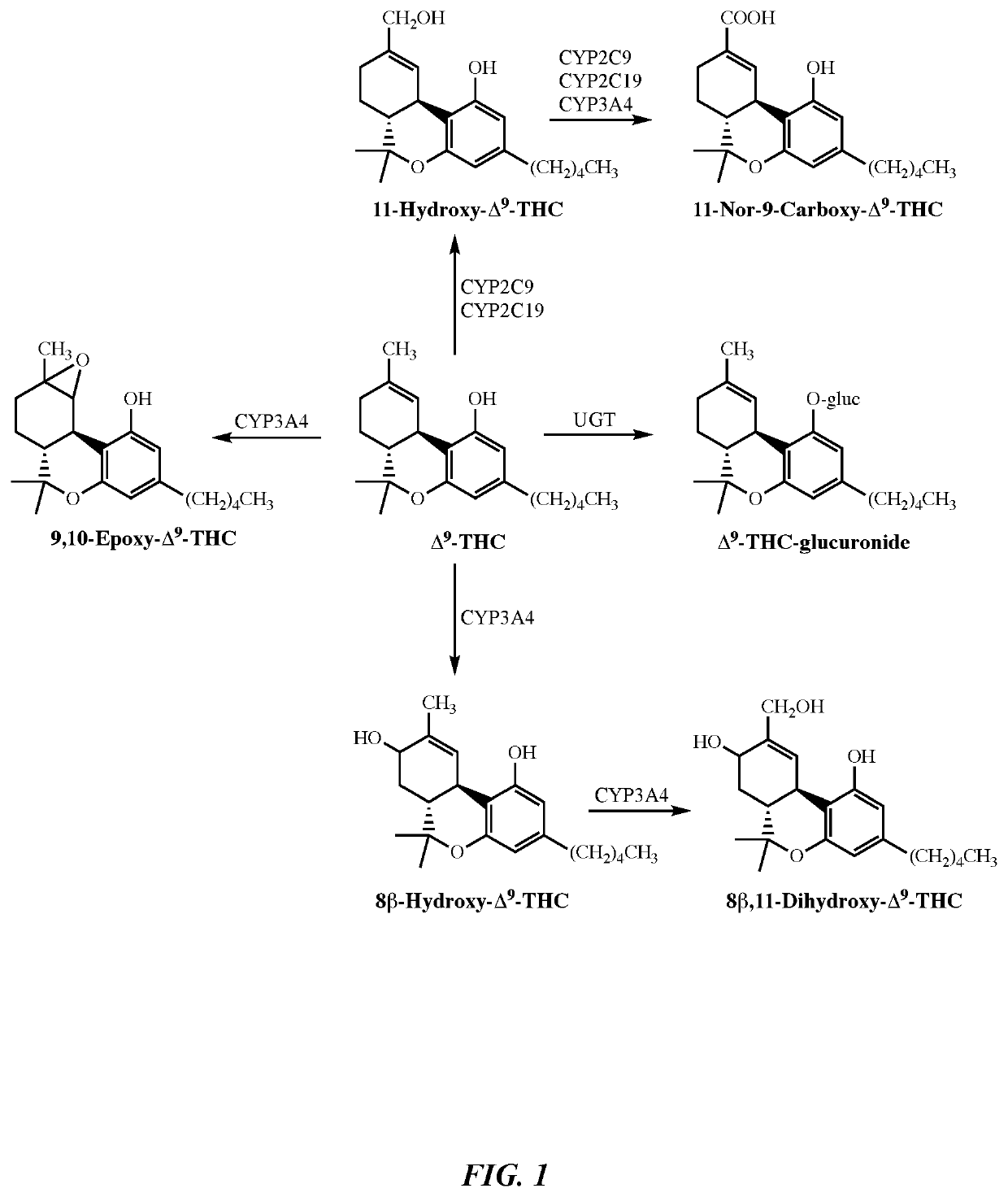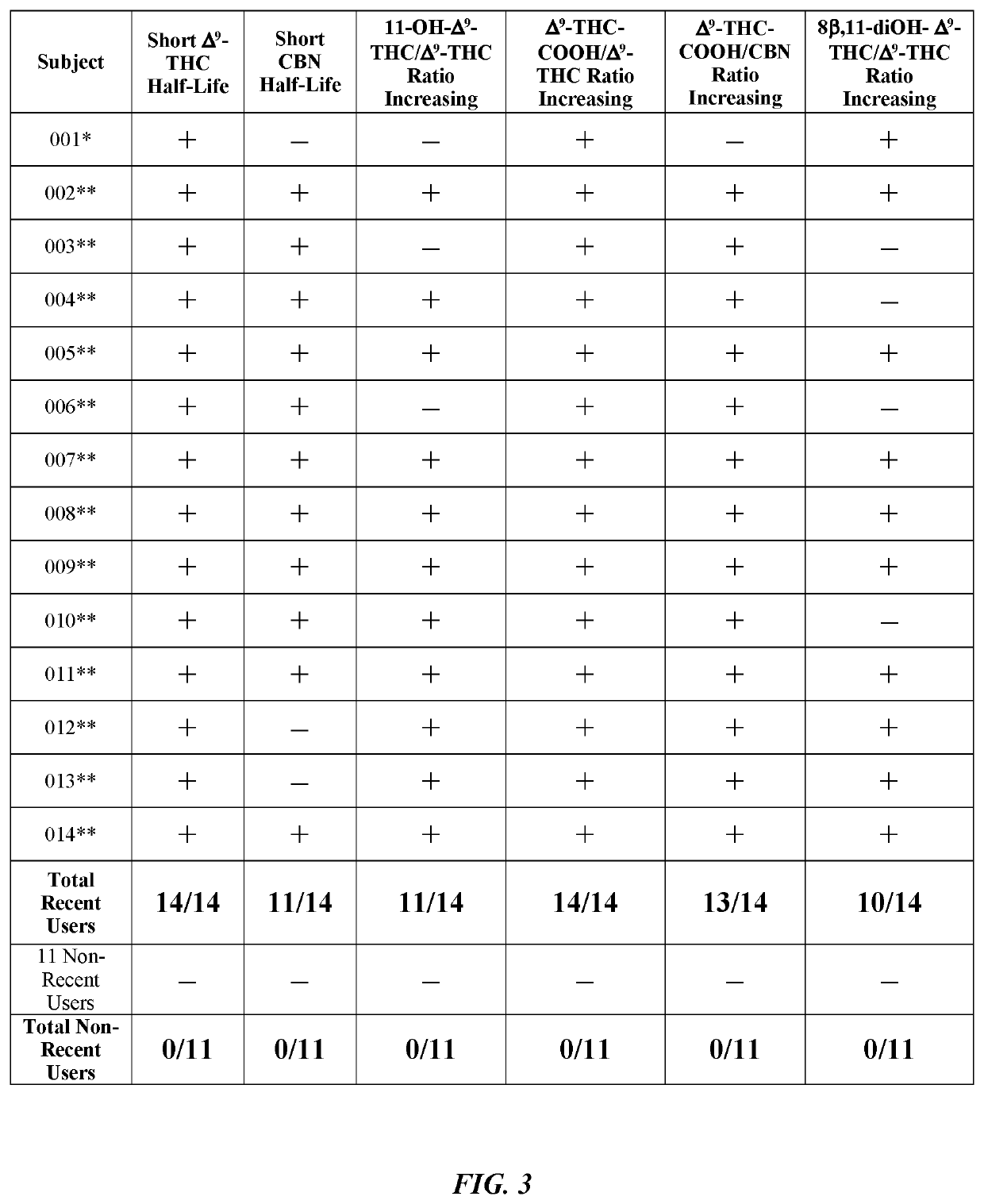Pharmacodynamic Model for Determining Last Use of Inhaled and Oral Cannabis Products
a technology of inhalation and oral cannabis, applied in the direction of diagnostic recording/measuring, instruments, applications, etc., can solve the problems of not showing whether these drivers were actually impaired, no reliable method of proving recent cannabis use in dui investigations, and complicating the assessment of impairment in dui investigations. , to achieve the effect of increasing the probability of recent us
- Summary
- Abstract
- Description
- Claims
- Application Information
AI Technical Summary
Benefits of technology
Problems solved by technology
Method used
Image
Examples
example 1
Determining Recent Use of Cannabis—Immediately After Smoking to 20 Minutes Post-Smoking
[0073]The goal of examining the 20-minute period immediately after smoking was to assess the ability of the described model to detect recent use of cannabis when the evidence of recent use should be at or near maximal levels.
[0074]A total of 14 subjects had blood samples collected immediately after smoking and 20 minutes post-smoking. Following written informed consent, subjects were given a cannabis cigarette to smoke that contained approximately 500 mg of a high-potency cannabis strain. Subjects were instructed to smoke the entire cigarette, or as much as they could, within a 10-minute period. Blood samples were collected using a either a standard lancet device (13 subjects) or the experimental blood draw device described above (1 subject). Blood samples were then extracted and analyzed for Δ9-THC, Δ9-THC metabolites, and other cannabinoids by liquid chromatography tandem mass spectrometry (LC-M...
example 2
Determining Recent Use of Cannabis—120 to 140 Minutes Post-Smoking
[0076]The goal of examining the time period approximately two hours after smoking was to evaluate the ability of the described model to predict recent use of cannabis in a more realistic setting, where someone smokes cannabis, decides to drive about an hour later, and is then tested for suspicion of DUI about two hours after having smoked.
[0077]A total of six subjects had blood samples collected at 120 minutes and 140 minutes post-smoking. Following written informed consent, subjects were given a cannabis cigarette to smoke that contained approximately 500 mg of a high-potency cannabis strain. Subjects were instructed to smoke the entire cigarette, or as much as they could, within a 10-minute period. Blood samples were collected using a either a standard lancet device (5 subjects) or the experimental blood draw device described above (1 subject). Blood samples were then extracted and analyzed for Δ9-THC, Δ9-THC metabo...
example 3
Determining Recent Use of Cannabis—180 to 200 Minutes Post-Smoking
[0080]The goal of evaluating the time period approximately three hours after smoking was to evaluate the ability of the model to predict recent use when pharmacologic evidence of such should be waning, but impairment is still possible.
[0081]A total of eight subjects had blood samples collected at 180 minutes and 200 minutes post-smoking. Following written informed consent, subjects were given a cannabis cigarette to smoke that contained approximately 500 mg of a high-potency cannabis strain. Subjects were instructed to smoke the entire cigarette, or as much as they could, within a 10-minute period. Blood samples were collected using a either a standard lancet device (7 subjects) or the experimental blood draw device described above (1 subject). Blood samples were then extracted and analyzed for Δ9-THC, Δ9-THC metabolites, and other cannabinoids by LC-MS / MS. Using the results, the following six parameters were then cal...
PUM
| Property | Measurement | Unit |
|---|---|---|
| time | aaaaa | aaaaa |
| time | aaaaa | aaaaa |
| lipophilic | aaaaa | aaaaa |
Abstract
Description
Claims
Application Information
 Login to View More
Login to View More - R&D
- Intellectual Property
- Life Sciences
- Materials
- Tech Scout
- Unparalleled Data Quality
- Higher Quality Content
- 60% Fewer Hallucinations
Browse by: Latest US Patents, China's latest patents, Technical Efficacy Thesaurus, Application Domain, Technology Topic, Popular Technical Reports.
© 2025 PatSnap. All rights reserved.Legal|Privacy policy|Modern Slavery Act Transparency Statement|Sitemap|About US| Contact US: help@patsnap.com



